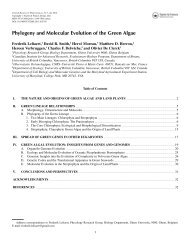Phylogeny and molecular evolution of green algae - Phycology ...
Phylogeny and molecular evolution of green algae - Phycology ...
Phylogeny and molecular evolution of green algae - Phycology ...
You also want an ePaper? Increase the reach of your titles
YUMPU automatically turns print PDFs into web optimized ePapers that Google loves.
2 CHAPTER 1<br />
Archaeplastida<br />
The monophyly <strong>of</strong> primary plastids has long been suggested by several features, such as a similar<br />
gene content <strong>of</strong> plastid genomes, the presence <strong>of</strong> plastid-specific gene clusters that are distinct from<br />
those found in Cyanobacteria, the conservation <strong>of</strong> the plastid-protein import machinery <strong>and</strong> proteintargeting<br />
signals, <strong>and</strong> phylogenies based on plastid <strong>and</strong> cyanobacterial gene sequences (Palmer<br />
2003). Nevertheless, several single-gene phylogenies <strong>and</strong> a few multigene phylogenies have<br />
challenged this hypothesis (e.g., Stiller et al. 2001, Nozaki et al. 2003a, Nozaki et al. 2003b, Stiller <strong>and</strong><br />
Harrell 2005). Conclusive evidence for the monophyly <strong>of</strong> the Glaucophyta, red <strong>algae</strong> <strong>and</strong> <strong>green</strong> plants<br />
was provided only relatively recently by Rodriguez-Ezpeleta et al. (2005) based on: (1) chloroplast<br />
gene phylogenies showing the monophyly <strong>of</strong> primary plastid <strong>and</strong> (2) a phylogenomic dataset<br />
containing 143 nuclear genes, ca. 30,000 amino acid positions which show the monophyly <strong>of</strong> all<br />
organisms with a primary plastid (Fig. 1). The latter study, however, could not reveal the relation<br />
among the three major lineages. Several nuclear genes suggest that red <strong>algae</strong> are the earliest<br />
diverging Archaeplastida, but such results are inconsistent with many plastid gene trees that identify<br />
glaucophytes as the earliest divergence. Most recent evidence favours the early divergence <strong>of</strong><br />
glaucophytes, as demonstrated by Reyes-Prieto et al. (2007) using a concatenated dataset <strong>of</strong><br />
conserved nuclear-encoded plastid targeted proteins <strong>of</strong> cyanobacterial origin. The latter <strong>evolution</strong>ary<br />
scenario corroborates with two important putatively ancestral characters shared by glaucophyte<br />
plastids <strong>and</strong> the cyanobacterial endosymbiont that gave rise to this organelle: the presence <strong>of</strong><br />
carboxysomes <strong>and</strong> a peptidoglycan deposition between the two organelle membranes. Both traits<br />
were apparently lost in the common ancestor <strong>of</strong> red <strong>and</strong> <strong>green</strong> <strong>algae</strong> after the divergence <strong>of</strong><br />
glaucophytes.<br />
Figure 2. The <strong>green</strong> <strong>algae</strong> exhibit a remarkable cytological diversity ranging from unicellar organisms (coccoid<br />
or flagellates), over multicellular filaments <strong>and</strong> foliose blades, to coenocytic <strong>and</strong> siphonous life forms that are<br />
essentially composed <strong>of</strong> a single giant cell containing countless nuclei (after Coppejans 1998). Arrows indicate<br />
trends in morphological complexity rather than <strong>evolution</strong>ary hypotheses. For example, <strong>green</strong> <strong>algae</strong> are thought<br />
to have evolved from a unicellular flagellate (the Ancestral Green Flagellate, AGF) rather than a coccoid life<br />
form.

















